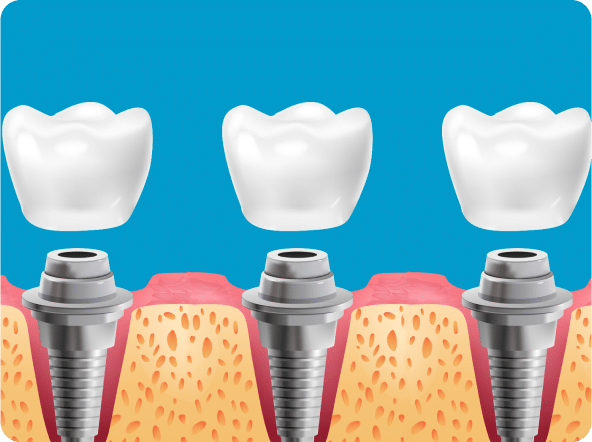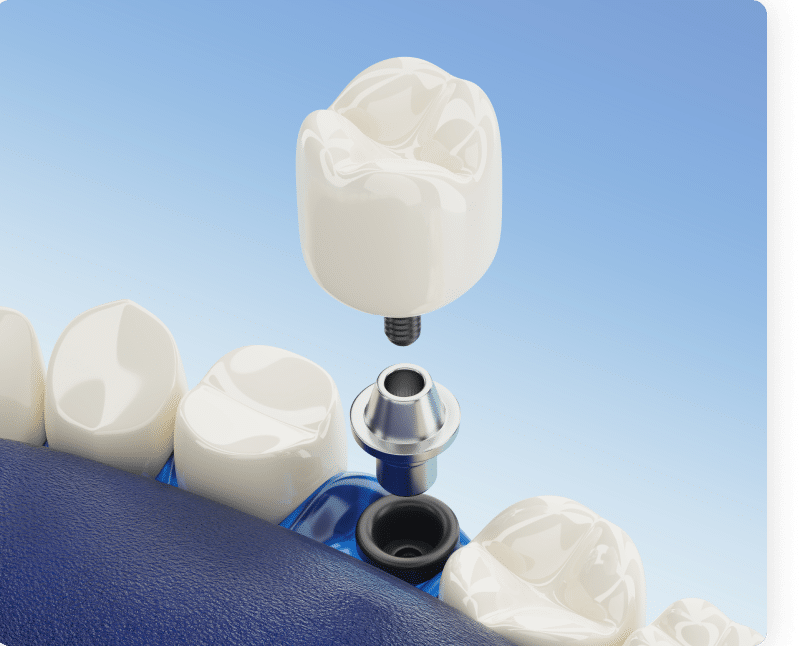Implant-Supported Crowns
Benefits of Implant-Supported Crowns
- Long-Lasting Support: While the crown will likely need replacement over time, implants can last for decades, if not a lifetime.
- Enhanced Function: Since dental implants merge with the bone and are permanent, they provide unmatched stability for your crown. It is much easier for you to enjoy eating your favorite foods and speak as your normally would.
- Natural Appearance: Implant-retained crowns replace the entire tooth, from crown to root, for a realistic appearance.
- Improved Oral Health: Because the dental implant stimulates your jawbone in the same way your natural tooth root does, patients can avoid bone breakdown and changes to the facial structure.
Can Dental Implants Work for You?

The Guide Will Show You
- Dental Implant Options
- Average Pricing
- Factors That Affect Eligibility
- And More!
Download our Dental Implant Pricing & Information Guide
Fill out the form below and we will email/text you the guide along with a $350 savings offer!
Am I a Candidate for an Implant
Supported Crown?
Most people with a missing tooth who are in good enough health to undergo oral surgery are candidates for an implant-supported crown. However, a common roadblock is a lack of jawbone tissue. When we lose teeth, the jawbone often thins and weakens over time. If you lack the jawbone to support an implant, you can undergo a bone graft to improve your candidacy.
In summary, individuals with a missing tooth can often opt for an implant-supported crown if they are healthy enough for surgery. When jawbone deficiency is present, a bone graft can enhance the chances of successful implant placement by augmenting the jawbone. This procedure enables patients who were previously ineligible for dental implants to have the opportunity for a restored smile and improved oral function.

What Should I Expect at My Appointment?

Treatment will typically require at least four dental visits. At the first appointment, you will meet with the dentist so he can evaluate your oral and overall health. At this time he will take a medical history, and images of your oral structure. If necessary, he may recommend a bone grafting surgery before or at the same time as your placement.
The second visit will usually be for the implant placement surgery. If any teeth need extraction, it will be done at this time. Next, a small incision is made at the gum line and a tiny access portal made into the jawbone. Through this, your dental implant is inserted. This entire implant placement process is guided by a surgical plan based on 3-D computerized tomography (CT) scans of your mouth. This allows for incredible precision in placing the implant, ensuring the least amount of trauma to surrounding tissues and optimal integration of the implant into the jawbone. Our office also offers sedation options, including nitrous oxide and oral conscious sedation, for your comfort.
Over the next four to six months, your dental implant will merge with the jawbone in a process known as osseointegration. As a result, the implant is backed by the strength and durability of your jawbone and essentially acts like a tooth root. After the osseointegration process is complete, you will return to have your abutments attached, which serve as a conduit between the implant and your crown. Finally, about two weeks later, you will return to have your dental crown attached.
Restore and Beautify Your Smile with Dental Crowns
Restore and beautify your smile today with dental crowns from Crowns & Caps. We pride ourselves on providing the highest quality of care and the most alluring results for our patients. Get in touch now for a consultation, so you can start your journey towards a beautiful, natural-looking smile!
The Process of Implant-Supported Crowns
Consultation and Evaluation
Treatment Planning
Implant Placement
Osseointegration
Abutment Placement
Crown Placement
Follow-up Care

Replace Single Missing Teeth with Implant-Supported Crowns
Meet The Team

Staunton Location

Bridgewater Location
Our Smiles for Life Patients Know
LaDawn Knicely
Cathy is always amazing. She remembers personal care details about my visit each time which shows me that she is a great listener, she has heard me and follows through with such care.
Cathy Ryan
I had Dr. Whiting for the first time and the practice will be in excellent hands when Dr. McIntire retires in Sept. He was profesional yet had an engaging demeanor when interacting with me. What makes this practice exceptional is the support staff- the welcoming friendliness of the front desk and the business office personnel. In particular, I would like to give high praises to the dental technician, Faith. She is warm, engaging and puts you at ease. She educates you during the whole process and is extremely knowledgeable about the procedures. Without a doubt, this is the best dental practice in the Valley.
Howard Dean
Dr. Whiting and staff did an excellent job. They were respectful, professional, and very helpful during the process of getting some dental implants. They expedited my appointments to get my new teeth before Father’s Day. Very happy with the results!
Susan Hairston
Dr. Mac performed a small miracle for me yesterday during my appointment. I was having an issue with my temporary bridge and he squeezed me in with his other patients to fix it. He went to great lengths to help me and I am very grateful. Thank you SFL!!
Dottie Westhafer
I had every intention of shopping around before committing to the extensive dental work I needed. However, after visiting the practice and seeing how dedicated they were to making life changing improvement for their patients, I looked no further. It is a process, starting with evaluations, recommendations, x-rays and scheduling. Beginning with my first appointment I marveled at the kindness, care and professionalism I received. I was taken care of skillfully and gently as we began my transformation. Today, June 6, 2024, I left their office with a beautiful smile without discoloration, wear, and misaligned teeth, and I now have a corrected bite and completely restored teeth that I am proud to show. Dr. Geo is very caring and meticulous, striving to complete his work with skill and perfection. I’m so glad that I came to Smiles For Life.
Charles Kimbrough
Smiles for Life has taken care of my dentistry needs for the last 6 years or so. Other offices in the past have had difficult times fitting me in when I needed an appointment. That hasn’t been the case here. Today, I needed to reschedule my appointment for next Monday, and they had an opening today with Cathy Batton instead of my regular hygienist. Cathy does a great job with years of experience and has a way about her to make you feel comfortable.
Linda Clague
Alex, . Morgan, and Dr Geo are very personable and professional. I felt very relaxed the entire visit.I especially appreciated Dr. Geo's careful mouth and teeth exam. They explained everything step by step and allowed time for questions.
Mclatt
On my first visit I meet Becky, we sat down and talked about everything they do there and she allowed me to tell her about my issues with my teeth and she felt that they could help me with my problem. This is the first time I have ever been able to explain, in detail, about my past and present experiences with my dental problems. She made me feel very comfortable in taking about my care and what I would like to have done with my denture issue's. I have set up my next appointment to have x-rays done and feel very good about that! I'm looking forward to my visit and what they have to say about fixing my problem .
